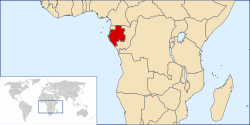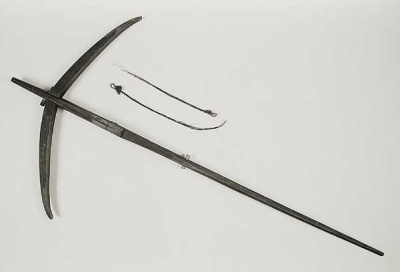Crossbow (1884.16.2)
 GabonCrossbow from Gabon, Africa. Part of the Pitt Rivers Museum Founding Collection. Given to the Museum in 1884.
GabonCrossbow from Gabon, Africa. Part of the Pitt Rivers Museum Founding Collection. Given to the Museum in 1884.
This wooden crossbow was used by the Fang and Mpongwe peoples of Gabon in west-central Africa. It has a rare and archaic 'split stock' trigger mechanism and was used with either iron-headed or poisoned arrows.
This crossbow played a central part in anthropologists' understanding of the spread and development of crossbows. Its acquisition in the mid 19th century also featured, on a wider scale, in a study on hitherto relatively unknown region and peoples in equatorial Africa.
A Place in History
This crossbow was collected by the explorer and gorilla-hunter, Paul du Chaillu in the 1850s. It then came into the hands of du Chaillu's fellow explorer, Robert Bruce N. Walker, who eventually gave it to General Pitt Rivers.
Du Chaillu's account, Explorations & Adventures in Equatorial Africa (1861), describes his encounter with these weapons and those who made and used them:
"Among the crowd today I saw men armed with crossbows, from which are shot either iron-headed arrows, or the little insignificant looking but really most deadly, poison-tipped arrows. These are only slender harmless reeds, a foot long, whose sharpened ends are dipped into a deadly vegetable poison, which these people know how to make. The arrows are so light that they would blow away if they were simply laid in the groove of the bow. To prevent this they use a kind of sticky gum, a lump of which is kept on the underside of the bow, and with which a small spot in the groove is lightly rubbed. The handle of the bow is ingeniously split, and by a little peg, which acts as a trigger, the bow-string is disengaged, and, as the spring is very strong, sends the arrow to a great distance, and light as it is, with great force. But the merest puncture kills inevitably. They are good marksmen with their bows, which require great strength to bend. They have to sit on their haunches, and apply both feet to the middle of the bow, while they pull with all their strength on the string to bend it back.
"The larger arrows have an iron head, something like the sharp barbs of a harpoon. These are used for hunting wild beasts, and are about two feet long. But the more deadly weapon is the little insignificant stick of bamboo, not more than 12 inches long, and simply sharpened at one end. This is the famed poison arrow - a missile which bears death wherever it touches, if only it pricks a pin's-point of blood. The poison is made of the juices of a plant, which was not shown me. They dip the sharp ends of the arrows several times in this sap, and let it get thoroughly dried into the wood. It gives the point a red colour. The arrows are very carefully kept in a little bag, made neatly of the skin of some wild animal. They are much dreaded among the tribes around here, as they can be thrown or projected with such power as to take effect at a distance of fifteen yards, and with such velocity that you cannot see them at all till they are spent. This I have proved myself. There is no cure for a wound from one of these harmless-looking sticks - death follows in a very short time" (pages 77-8).
Aside from the peoples of Gabon, only the Mandingo and Yoruba of southern Nigeria, and a small number of other peoples around the Bight of Benin and northern Cameroon, were known to use this type of crossbow. It bears no formal relationship to crossbows of east Africa, which were influenced by Indian Ocean models, and this intrigued the anthropologists of the time. Henry Balfour wrote an article in 1909 as a result of much speculation about the origins of these weapons, comparing them to a multitude of other crossbow forms. Bizarrely, but seemingly correct, the unique split-stock release mechanism is only comparable with very archaic Scandinavian fishing crossbows, where it is constructed in an almost identically way. Balfour also used images from Benin bronze-castings to show that the crossbow of Benin was formerly of this type, before undergoing certain changes in more recent times. His concluding thesis supposes that this simple Scandinavian form was, in the late Medieval period, much more widespread across Western and Northern Europe, where it was transmitted to the Bight of Benin by men involved in the trade for gold or slaves.





